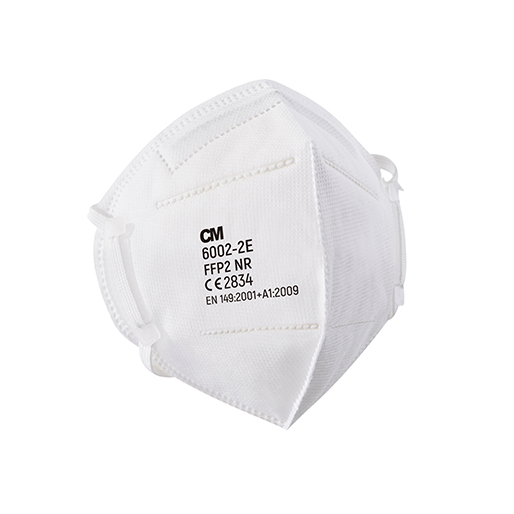
Particle filtering half mask (6002-2E FFP2)
Material composition
The surface layer is 50g non-woven fabric, the second layer is 45g hot-air cotton, the third layer is 50g FFP2 filter material, and the inner layer is 50g non-woven fabric.
Application field
Applicable industries: Suitable for casting, laboratory, primer, cleaning and hygiene, chemical pesticides, solvent cleaning, painting, printing and electroplating, electronics, food processing, automobile and ship repair, ink dyeing and finishing, environmental disinfection and other harsh environments
It can be used to protect particles produced during grinding, sanding, cleaning, sawing, bagging, etc., or during the processing of ore, coal, iron ore, flour, metal, wood, pollen and certain other substances, liquid or non-oily particulate matter produced by spraying that does not emit oily aerosols or vapours
This product complies with the requirements of EU Regulation (EU) 2016/425 for Personal Protective Equipment and meets the requirements of European standard EN 149:2001+A1:2009. At the same time, it complies with the requirements of EU Regulation (EU) MDD 93/42/EEC on medical devices and meets the requirements of European Standard EN 14683-2019+AC:2019.
User instructions
The mask must be selected properly for intended application. An individual risk assessment must be evaluated. Check the respirator that is undamaged with no visible defects. Check the expiry date that has not been reached (see the packaging). Check the protection class that is appropriate for the product used and its concentration. Do not use the mask if a defect is present or the expiry date has been exceeded. Failure to follow all instructions and limitations could seriously reduce the effectiveness of this particle filtering half mask and could lead to illness, injury or death. A properly selected respirator is essential, before occupational use, the wearer must be trained by the employer in the correct use of the respirator in accordance with applicable safety and health standards.
Intended use
This product is limited to surgical operations and other medical environment where infectious agents are transmitted from staff to patients. The barrier should also be effective in reducing oral and nostril discharge of infectious substances from asymptomatic carriers or clinically symptomatic patients and in protecting against solid and liquid aerosols in other environments.
Using method
1. Hold the mask in hand with the nose clip up. Allow head harness to hang freely.
2. Position the mask under the chin covering mouth and nose.
3. Pull the head harness over the head and position behind head, adjust the length of head harness with adjustable buckle to feel as comfortable as possible.
4. Press soft nose clip to conform snugly around the nose.
5. To check fit, cup both hands over the mask and exhale vigorously. If air flows around nose, tighten the nose clip. If air leaks around the edge, reposition the head harness for better fit. Re-check the seal and repeat the procedure until the mask is sealed properly.

Respirators are designed to help reduce the wearer’s respiratory exposure to airborne contaminants such as particles, gases, or vapours. Respirators and filters must be selected based on the hazards present. They come in various sizes and styles, and should be individually selected to fit the wearer’s face and to provide a tight seal. A proper seal between the user’s face and the respirator forces inhaled air to be pulled through the respirator’s filter material, thereby providing protection. Wearers should be fit tested to make sure they are using the appropriate model and size of respirator to get the best fit. A seal check should be done each time a respirator is worn.
Principle of protection from face masks against aerosols and large droplets
Theoretically, respiratory viruses can be transmitted through fine aerosols (droplets and droplet nuclei with aerodynamic diameters 5 mm), respiratory droplets (including larger droplets that fall rapidly near the source, as well as coarse aerosols with aerodynamic diameters > 5 mm), or direct contact with secretions. A face mask provides a barrier to prevent the respiratory tract from being exposed to droplets and airborne aerosols. The physical interception, therefore, reduces the risk of respiratory viral infections (RVIs). Particles can be ejected several meters from a coughing or sneezing patient. These particles vary significantly in size, which, in turn, affects the distance from the source that the particles travel through the air. Large particles will precipitate on surfaces of laptops, desks, chairs, and any other items nearby, but the smaller ones will be suspended in air for a much longer time, and travel further, depending on airflow dynamics. Aerosols refer to the small end of airborne water droplets exhaled from or sneezed out of a patient, with typical sizes below 2-3μm. They remain airborne for prolonged periods because of their small size and low settling velocity.
Cautions
It is single use. It should be discarded when
● becomes damaged or deformed,
● no longer forms an effective seal to the face,
● becomes wet or visibly dirty,
● breathing through it becomes more difficult, or
● becomes contaminated with blood, respiratory or nasal secretions, or other bodily fluids.








